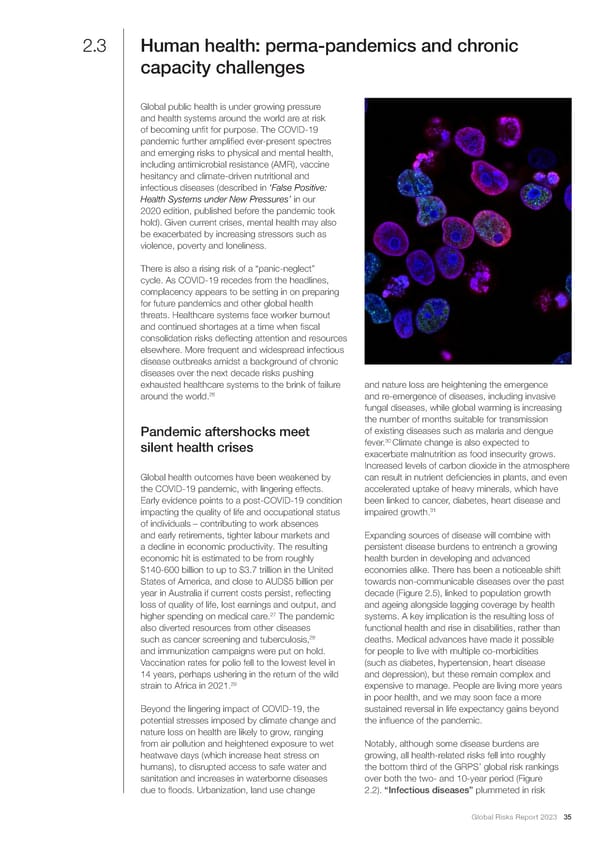2.3 Human health: perma-pandemics and chronic capacity challenges Global public health is under growing pressure and health systems around the world are at risk of becoming un昀椀t for purpose. The COVID-19 pandemic further ampli昀椀ed ever-present spectres and emerging risks to physical and mental health, including antimicrobial resistance (AMR), vaccine hesitancy and climate-driven nutritional and infectious diseases (described in ‘False Positive: Health Systems under New Pressures’ in our 2020 edition, published before the pandemic took hold). Given current crises, mental health may also be exacerbated by increasing stressors such as violence, poverty and loneliness. There is also a rising risk of a “panic-neglect” cycle. As COVID-19 recedes from the headlines, complacency appears to be setting in on preparing for future pandemics and other global health threats. Healthcare systems face worker burnout and continued shortages at a time when 昀椀scal consolidation risks de昀氀ecting attention and resources elsewhere. More frequent and widespread infectious disease outbreaks amidst a background of chronic diseases over the next decade risks pushing exhausted healthcare systems to the brink of failure and nature loss are heightening the emergence 26 around the world. and re-emergence of diseases, including invasive fungal diseases, while global warming is increasing the number of months suitable for transmission Pandemic aftershocks meet of existing diseases such as malaria and dengue 30 silent health crises fever. Climate change is also expected to exacerbate malnutrition as food insecurity grows. Increased levels of carbon dioxide in the atmosphere Global health outcomes have been weakened by can result in nutrient de昀椀ciencies in plants, and even the COVID-19 pandemic, with lingering effects. accelerated uptake of heavy minerals, which have Early evidence points to a post-COVID-19 condition been linked to cancer, diabetes, heart disease and impacting the quality of life and occupational status impaired growth.31 of individuals – contributing to work absences and early retirements, tighter labour markets and Expanding sources of disease will combine with a decline in economic productivity. The resulting persistent disease burdens to entrench a growing economic hit is estimated to be from roughly health burden in developing and advanced $140-600 billion to up to $3.7 trillion in the United economies alike. There has been a noticeable shift States of America, and close to AUD$5 billion per towards non-communicable diseases over the past year in Australia if current costs persist, re昀氀ecting decade (Figure 2.5), linked to population growth loss of quality of life, lost earnings and output, and and ageing alongside lagging coverage by health 27 higher spending on medical care. The pandemic systems. A key implication is the resulting loss of also diverted resources from other diseases functional health and rise in disabilities, rather than such as cancer screening and tuberculosis,28 deaths. Medical advances have made it possible and immunization campaigns were put on hold. for people to live with multiple co-morbidities Vaccination rates for polio fell to the lowest level in (such as diabetes, hypertension, heart disease 14 years, perhaps ushering in the return of the wild and depression), but these remain complex and 29 strain to Africa in 2021. expensive to manage. People are living more years in poor health, and we may soon face a more Beyond the lingering impact of COVID-19, the sustained reversal in life expectancy gains beyond potential stresses imposed by climate change and the in昀氀uence of the pandemic. nature loss on health are likely to grow, ranging from air pollution and heightened exposure to wet Notably, although some disease burdens are heatwave days (which increase heat stress on growing, all health-related risks fell into roughly humans), to disrupted access to safe water and the bottom third of the GRPS’ global risk rankings sanitation and increases in waterborne diseases over both the two- and 10-year period (Figure due to 昀氀oods. Urbanization, land use change 2.2). “Infectious diseases” plummeted in risk Global Risks Report 2023 35
 2023 | Global Risks Report Page 34 Page 36
2023 | Global Risks Report Page 34 Page 36